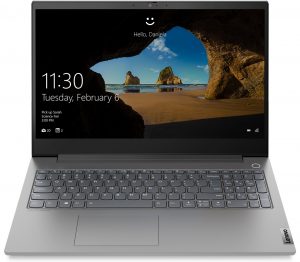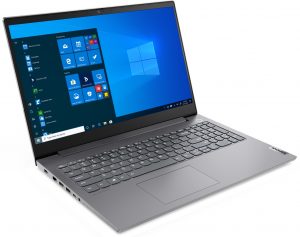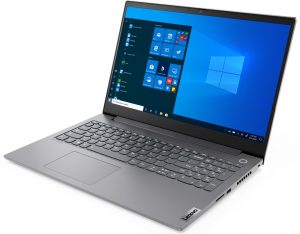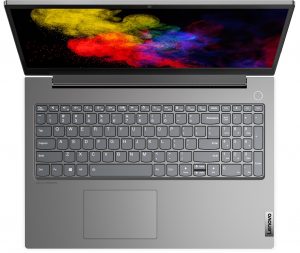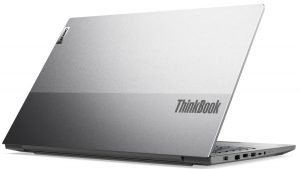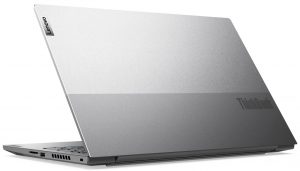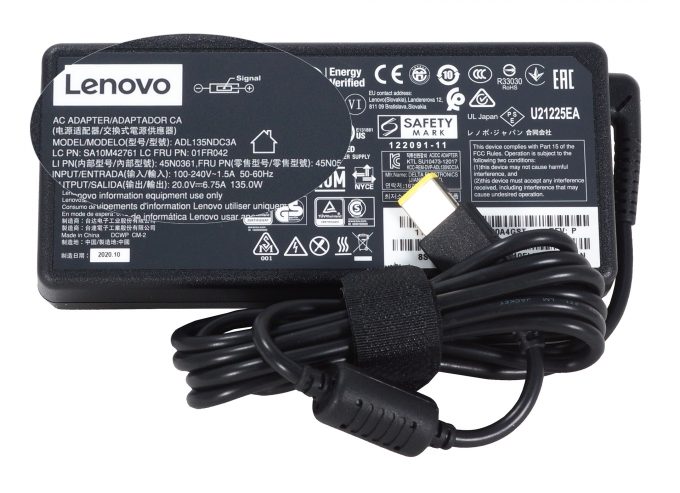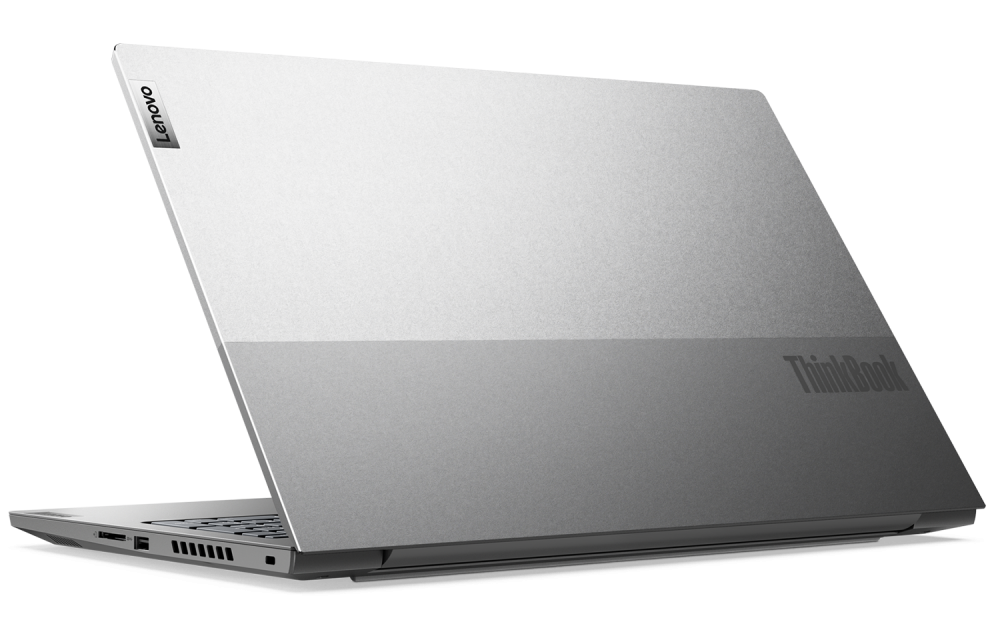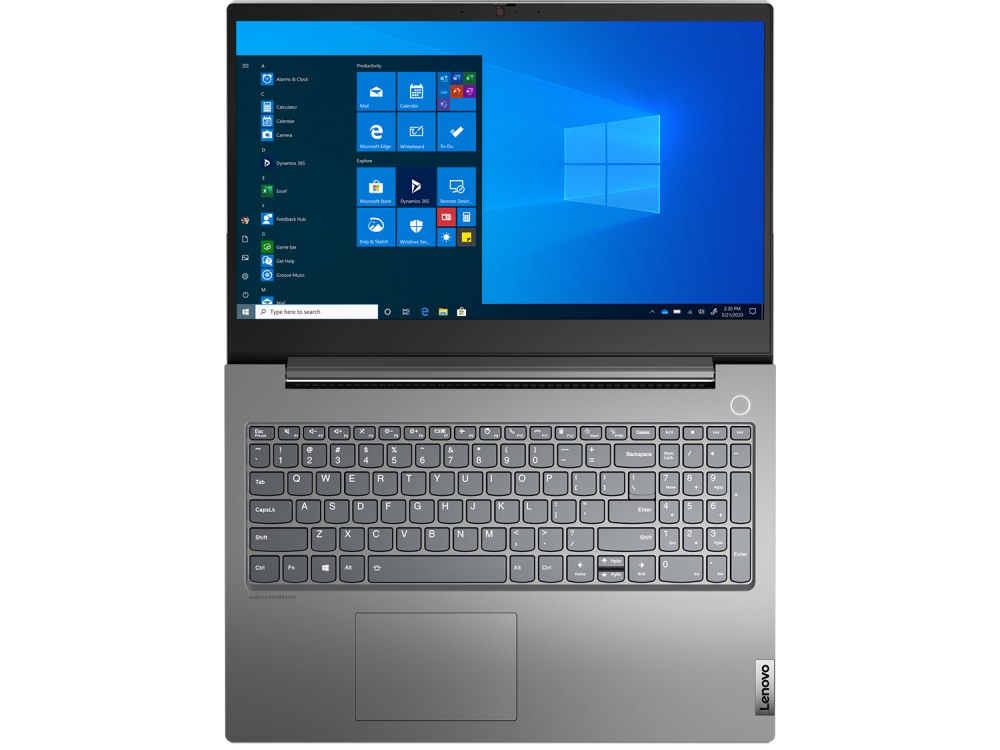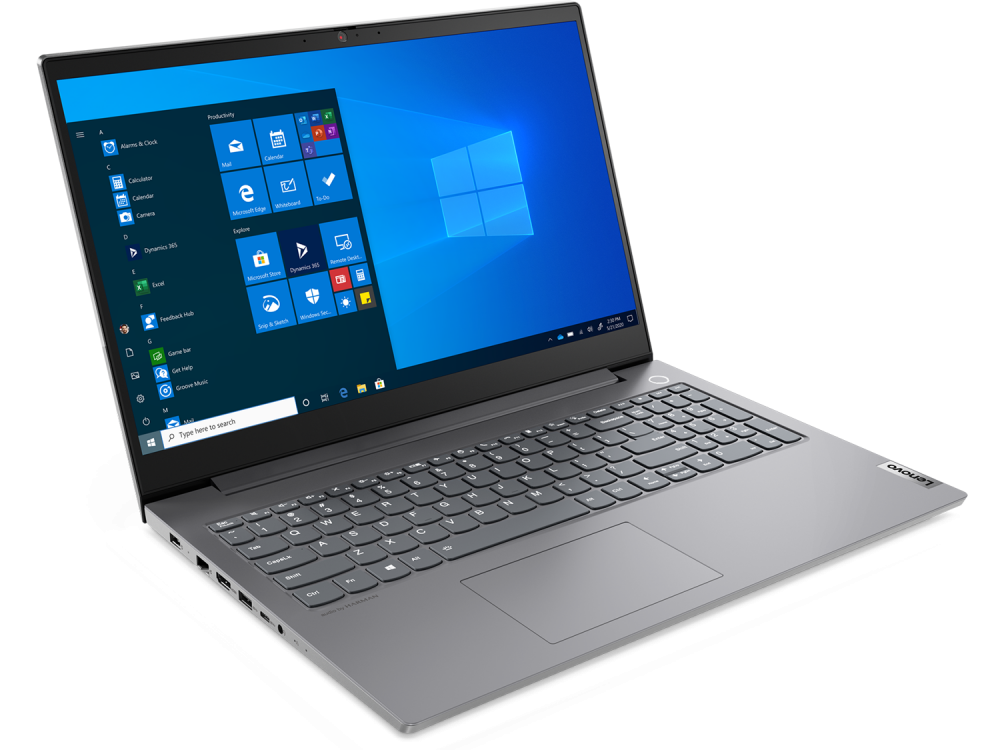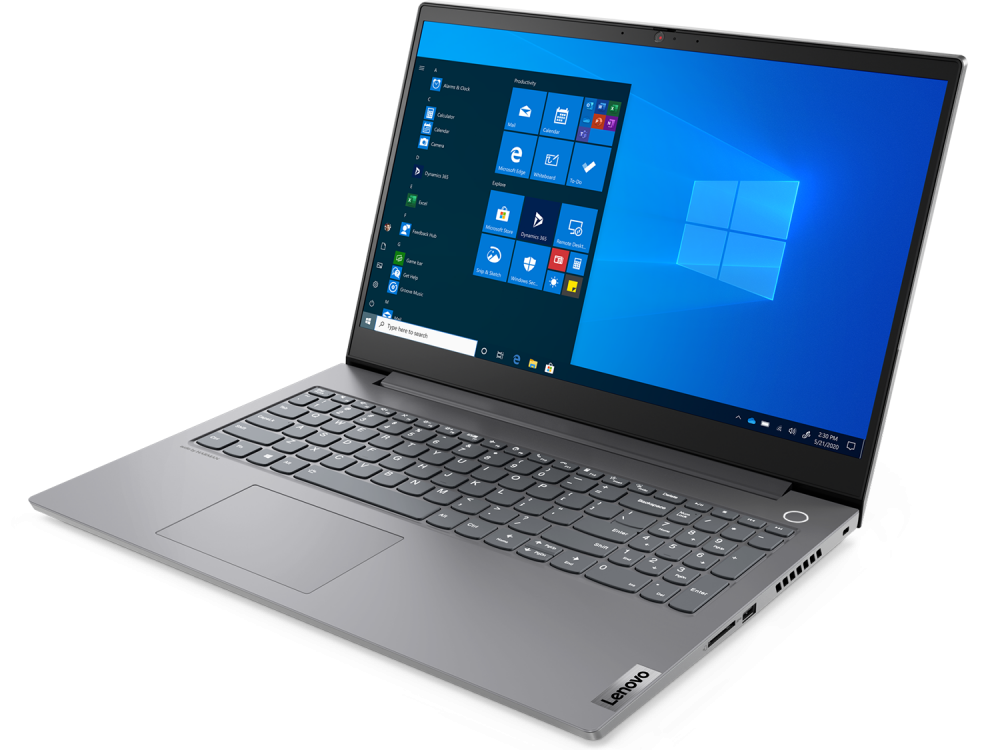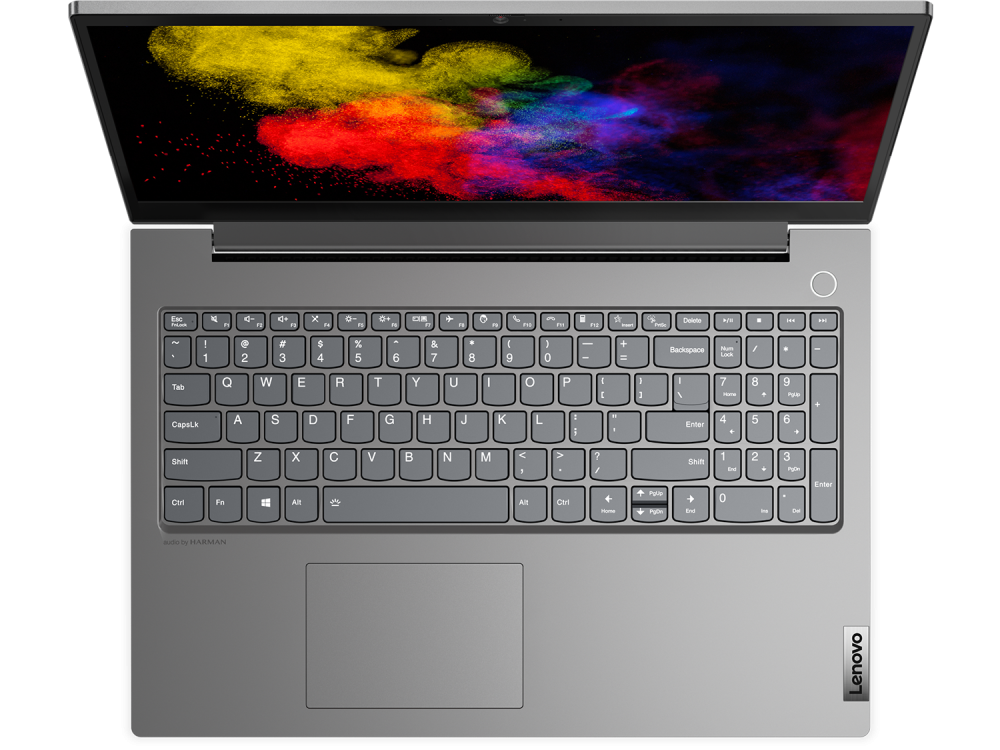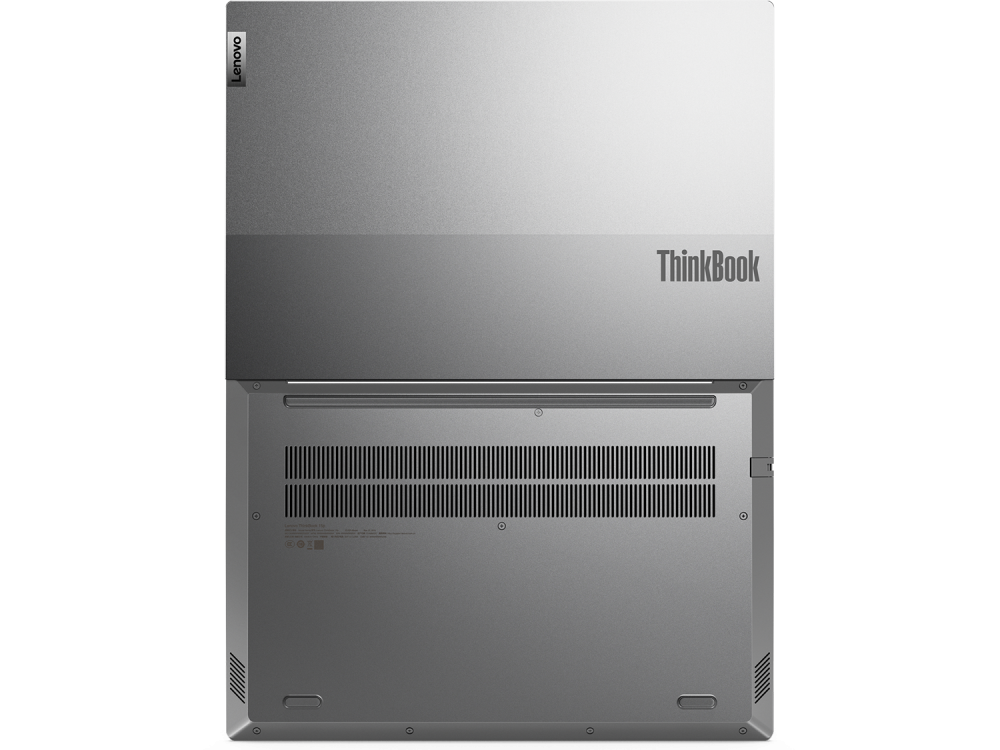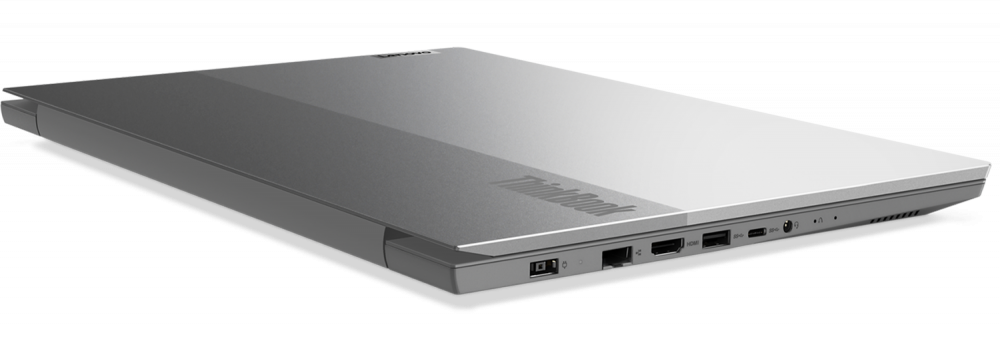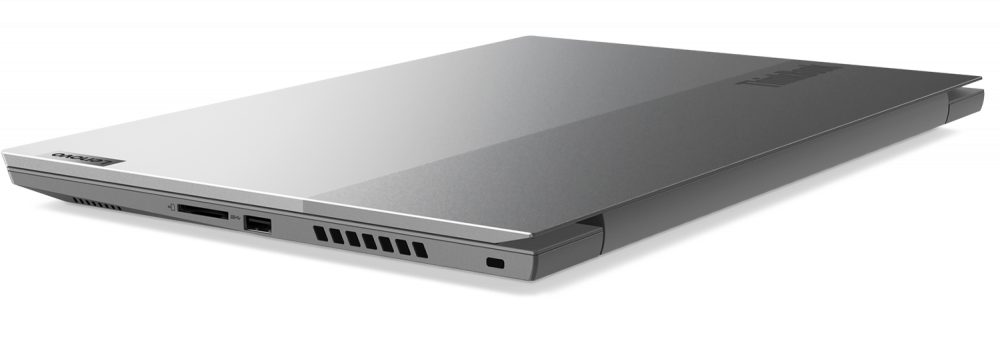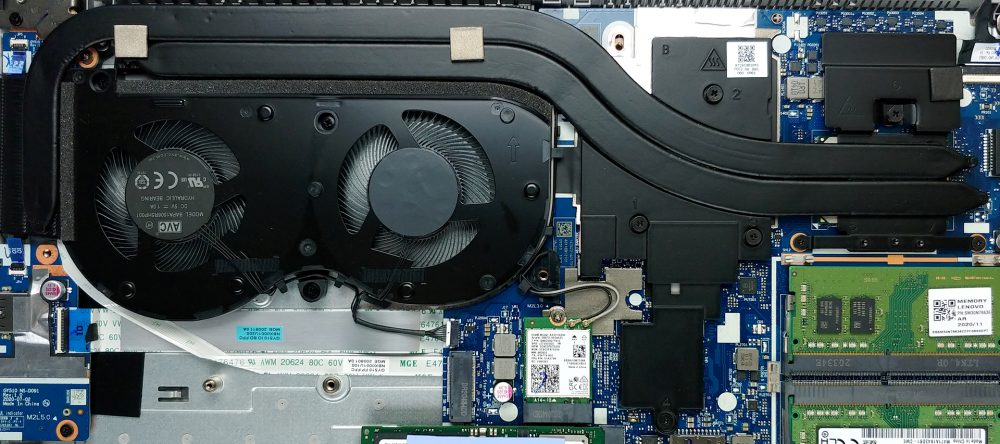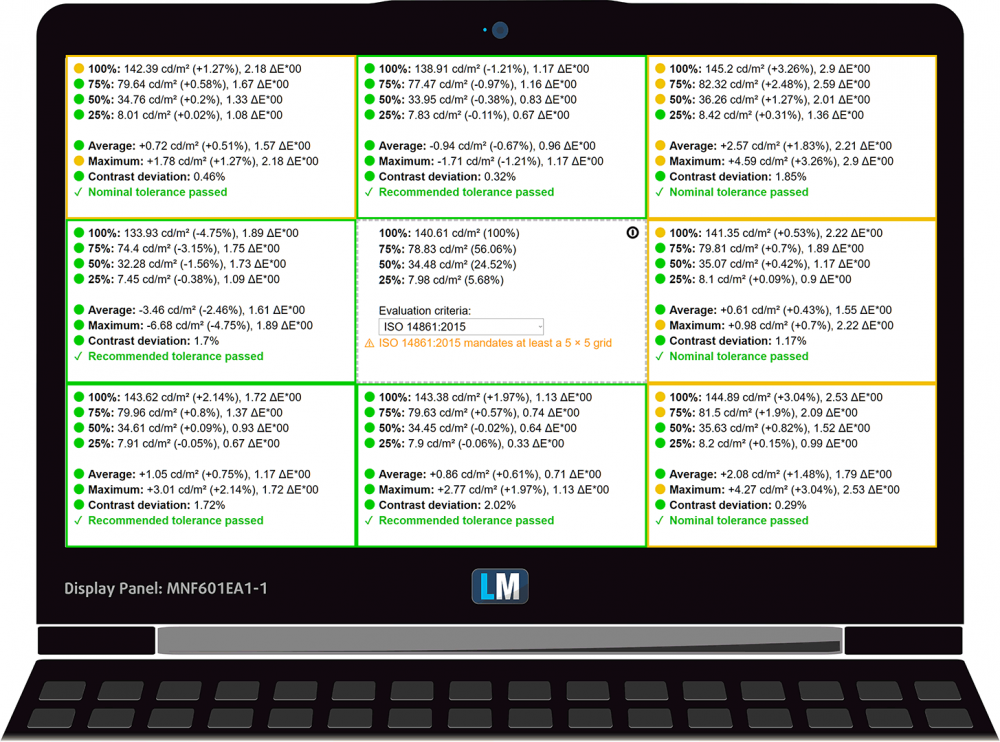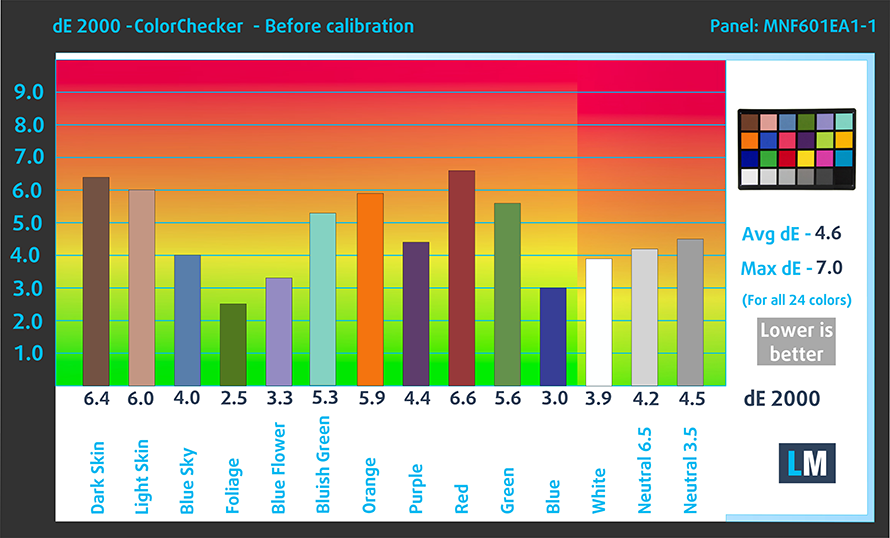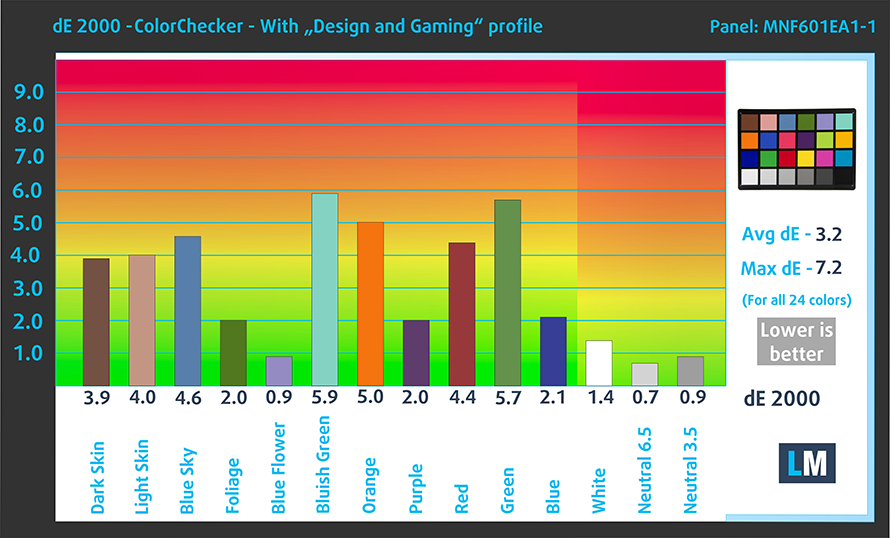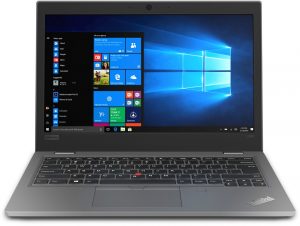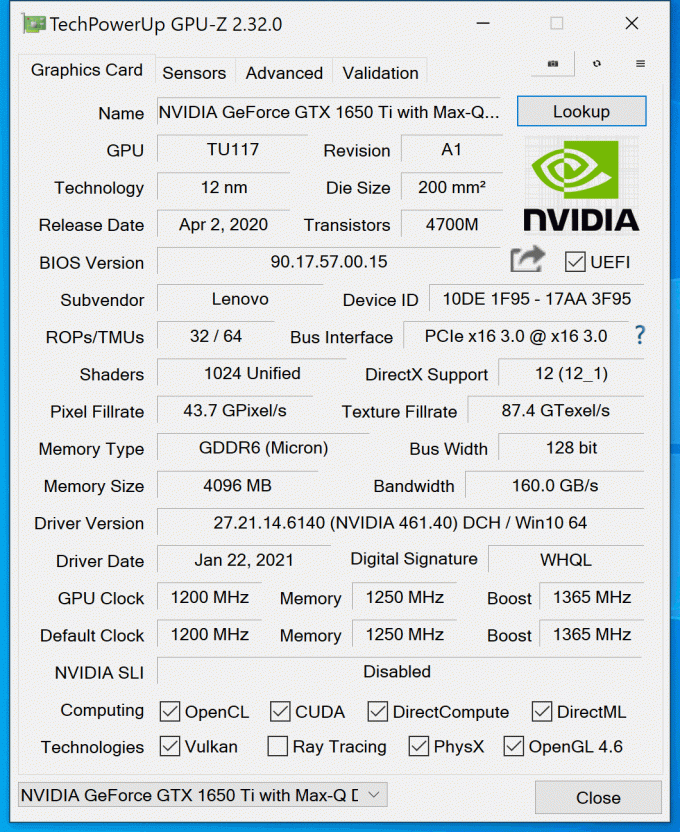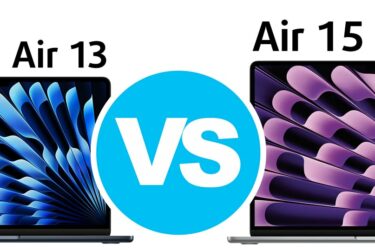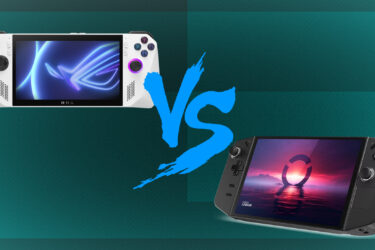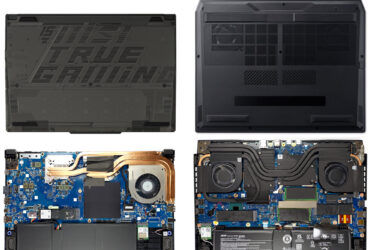Lenovo ThinkBook 15p review – business class, content creator notebook
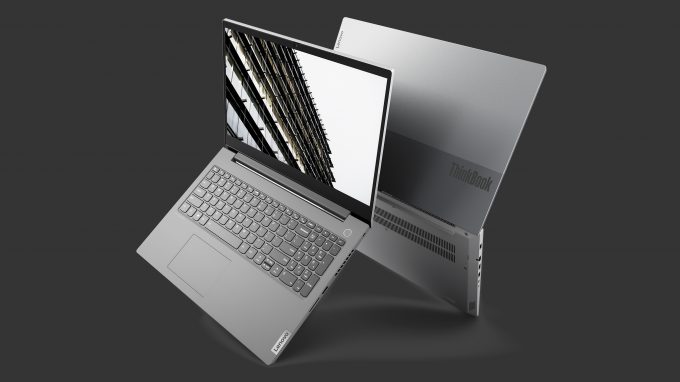 If business laptops had Max-P versions, the ThinkBook 15p would be one of them. It is far more capable than its genuine ThinkBook 15 brother in terms of getting the job done. This, respectively, is because of an overhaul of the hardware, and the cooling solution.
If business laptops had Max-P versions, the ThinkBook 15p would be one of them. It is far more capable than its genuine ThinkBook 15 brother in terms of getting the job done. This, respectively, is because of an overhaul of the hardware, and the cooling solution.
Lenovo says, that this notebook falls not only in the business category, but it’s also meant to appeal to content creators. In order to satisfy this growing, and ever-demanding target group, they offer 45W processors, maxing out with the Core i7-10870H, while the graphics are handled by the Max-Q versions of the GTX 1650, and GTX 1650 Ti.
So far so good – it is nothing way too powerful, so we think that you won’t get an uncomfortably loud notebook. And it is very important to have sleek looks, instead of the aggressive vibe that the gamer notebooks give. Additionally, there is one more important feature – the display. Actually, Lenovo is very proud of its 4K IPS option, which in their words delivers 100% Adobe RGB coverage, and is X-Rite calibrated along with the Pantone standards. Also, it boasts 600 nits of maximum brightness. And for those of us who can’t afford a yacht, they have the modest but still decent 1080p IPS model, which shines at 300 nits, and supposedly covers 100% of the sRGB gamut.
You can check the prices and configurations in our Specs System: https://laptopmedia.com/series/lenovo-thinkbook-15p
Contents
Specs Sheet
- HDD/SSD
- up to 2000GB SSD
- M.2 Slot
- 2x 2280 PCIe NVMe 3.0 x4 See photo
- RAM
- up to 64GB
- OS
- Windows 10 Pro, Windows 11 Pro, No OS, Windows 10 Home
- Battery
- 57Wh
- Body material
- Aluminum
- Dimensions
- 359 x 249.5 x 19.9 mm (14.13" x 9.82" x 0.78")
- Weight
- 1.90 kg (4.2 lbs)
- Ports and connectivity
- 1x USB Type-C
- 3.2 Gen 1 (5 Gbps)
- 2x USB Type-A
- 3.2 Gen 1 (5 Gbps)
- HDMI
- 2.0
- Card reader
- MMC, SD, SDHC, SDXC
- Ethernet LAN
- 10, 100, 1000 Mbit/s
- Wi-Fi
- 802.11ac
- Bluetooth
- 5.0
- Audio jack
- 3.5mm Combo Jack
- Features
- Fingerprint reader
- optional
- Web camera
- HD
- Backlit keyboard
- Microphone
- Dual Array Digital Microphone
- Speakers
- 2x 2W, Dolby Audio
- Optical drive
- Security Lock slot
- Kensington Lock
All Lenovo ThinkBook 15p configurations
What’s in the box?
Inside the box, you will find the mandatory paperwork, as well as a 135W power adapter.
Design and construction
Now, let’s take a look at the design. This device is built out of aluminum, although the base feels like plastic. Without a doubt, we can say that we are huge fans of the appearance. On the lid, you can see a dual-tone gray finish, with chamfered edges. Also, the lid looks pointy at the back, which is also cool. Interestingly, the body is extremely rigid with almost no flex all around. Unfortunately, this cannot be said about the lid, which bends like cheese in the microwave. Also, we observed color-shifting when we twisted it.
How about its portability? Well, the notebook weighs 1.90 kg and has a profile of 19.9mm, which is very good for something with so much horsepower.
Its lid opens with a single hand, and the hinges feel smooth, with just the right resistance. Once you open it, you will see the matte display. Its side bezels are narrow, but it has a quite large forehead and a formidable chin. On the bright side, the top bezel packs the HD camera, as well as a privacy shutter.
Next, let’s move to the base. As we said, we found very little flex in the chassis, and almost no deck flex, which is great. Northeast to the keyboard, you can find the Power button, which doubles as a fingerprint reader. As far as the keyboard, itself, you get a full-sized one with a NumberPad, and a Service Hotkey, which should make support and maintenance extremely hassle-free. This unit is also backlit, and while the feedback is clicky and satisfying, we found that the very short key travel kind of took away from the satisfaction. Another thing we’re not fans of is the way too small “Up” and “Down” Arrow keys.
With a palm rest area so big, Lenovo could have provided a larger touchpad. Instead, they opted for the traditional one, which has a Mylar surface, that provides smooth gliding. And although the tracking feels a bit weird at first, you can get used to it pretty quickly.
Lastly, let’s turn the laptop upside down, and see the two speaker cutouts, which hide the Harman-tuned speakers. Also, there is an air intake grill there, while the heat is exhausted from the right side, and from in between the lid and the base.
Ports
When it comes to the I/O, you get the charging plug, an RJ-45 connector, an HDMI 2.0 connector, a USB Type-A 3.2 (Gen. 1) port, a USB Type-C 3.2 (Gen. 1) port with data transfer only, and an Audio jack on the left. On the other side, you get one more USB Type-A 3.2 (Gen. 1) port, and an SD card reader.
Disassembly, upgrade options, and maintenance
To get inside this notebook, you need to undo all 10 Phillips-head screws. Then carefully pry your way around the bottom panel, starting from the back.
In terms of cooling, you get two heat pipes that connect to one rather long heat spreader, and a tiny one on the left of the fan. By the way, the cooling solution here is very similar to that of the Ideapad Gaming 3i 15, however, this time you get two fans that are equal in size. Additionally, you can see some metal heat sinks above the VRMs, the graphics memory, as well as the chipset.
In regards to the upgradeability, there are two RAM SODIMM slots, that support up to 32GB of DDR4 memory in dual-channel mode. Storage-wise, you get two M.2 PCIe x4 slots.
As for the battery, this device is equipped with a 57Wh package, which can be charged from 0-80% for just one hour.
Display quality
Lenovo ThinkBook 15p comes with a UHD IPS panel. It bears a model number MNF601EA1-1 (CSO1500) and has a diagonal of 15.6″ (39.62 cm), and a resolution of 3840 x 2160 pixels. The screen ratio is 16:9, and we are looking at a pixel density of – 282 ppi, and a pitch of 0.09 х 0.09 mm. The screen turns into Retina when viewed at distance equal to or greater than 30cm (12″) (from this distance one’s eye stops differentiating the separate pixels, and it is normal for looking at a laptop).
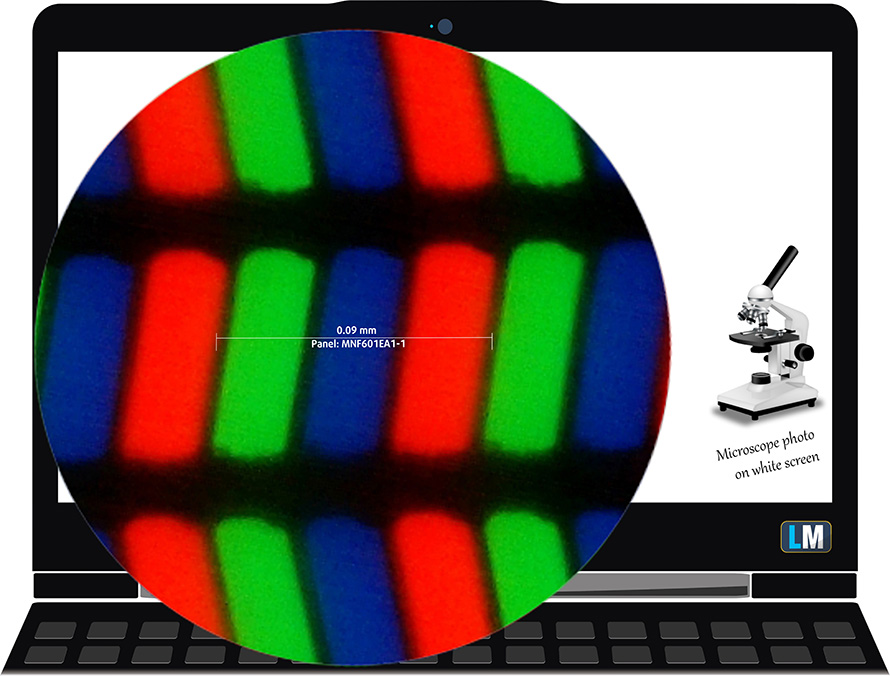
It has excellent viewing angles. We offer images at 45° to evaluate image quality.

The measured maximum brightness (HDR ON) is 500 nits in the middle of the screen and 490 nits as an average for the whole area, with a maximum deviation of 6%. The Correlated Color Temperature on a white screen is 6980K – colder than the optimal for the sRGB standard of 6500K.
In the illustration below you can see how the display performs from a uniformity perspective. In other words, the leakage of light from the light source.
Values of dE2000 over 4.0 should not occur, and this parameter is one of the first you should check if you intend to use the laptop for color-sensitive work. The contrast ratio is good – 1540:1.
To make sure we are on the same page, we would like to give you a little introduction to the sRGB color gamut and the Adobe RGB. To start, there’s the CIE 1976 Uniform Chromaticity Diagram that represents the visible specter of colors by the human eye, giving you a better perception of the color gamut coverage and the color accuracy.
Inside the black triangle, you will see the standard color gamut (sRGB) that is being used by millions of people on HDTV and on the web. As for the Adobe RGB, this is used in professional cameras, monitors, etc for printing. Basically, colors inside the black triangle are used by everyone and this is the essential part of the color quality and color accuracy of a mainstream notebook.
Still, we’ve included other color spaces like the famous DCI-P3 standard used by movie studios, as well as the digital UHD Rec.2020 standard. Rec.2020, however, is still a thing of the future and it’s difficult for today’s displays to cover that well. We’ve also included the so-called Michael Pointer gamut, or Pointer’s gamut, which represents the colors that naturally occur around us every day.
The yellow dotted line shows Lenovo ThinkBook 15p’s color gamut coverage.
Its display covers 98% of the sRGB/ITU-R BT.709 (web/HDTV standard) in CIE1976. It also covers 97% of Adobe RGB and 91% of DCI-P3.
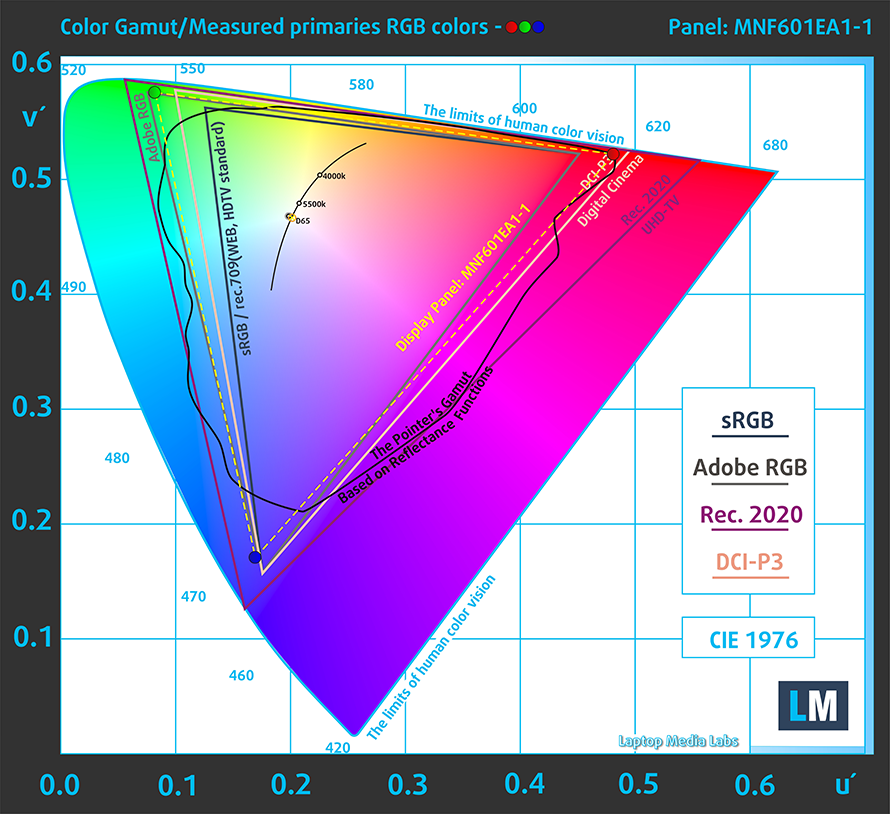
Our “Design and Gaming” profile delivers optimal color temperature (6500K) at 140 cd/m2 luminance and sRGB gamma mode.
We tested the accuracy of the display with 24 commonly used colors like light and dark human skin, blue sky, green grass, orange, etc. You can check out the results at factory condition and also, with the “Design and Gaming” profile.
Below you can compare the scores of Lenovo ThinkBook 15p with the default settings (left), and with the “Gaming and Web design” profile (right).
The next figure shows how well the display is able to reproduce really dark parts of an image, which is essential when watching movies or playing games in low ambient light.
The left side of the image represents the display with stock settings, while the right one is with the “Gaming and Web Design” profile activated. On the horizontal axis, you will find the grayscale, and on the vertical axis – the luminance of the display. On the two graphs below you can easily check for yourself how your display handles the darkest nuances but keep in mind that this also depends on the settings of your current display, the calibration, the viewing angle, and the surrounding light conditions.
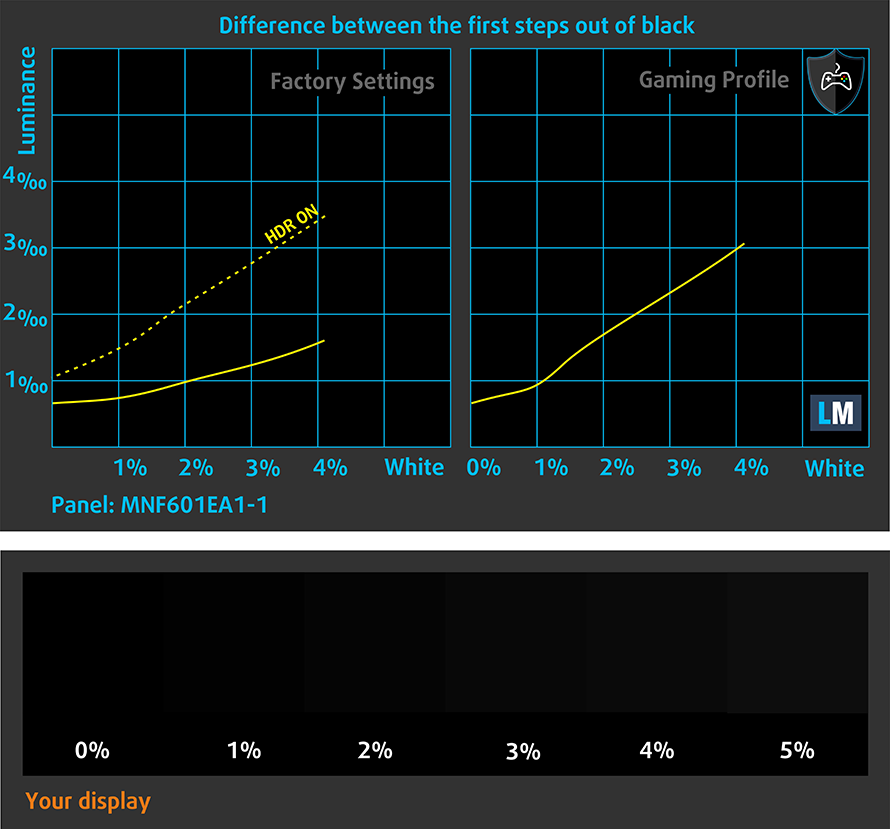
Response time (Gaming capabilities)
We test the reaction time of the pixels with the usual “black-to-white” and “white-to-black” method from 10% to 90% and vice versa.
We recorded Fall Time + Rise Time = 26 ms.
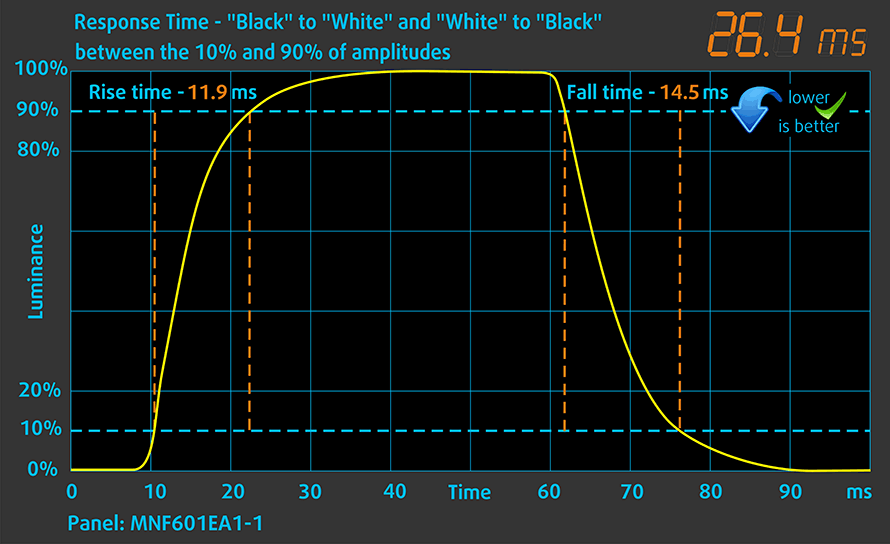
PWM (Screen flickering)
Pulse-width modulation (PWM) is an easy way to control monitor brightness. When you lower the brightness, the light intensity of the backlight is not lowered, but instead turned off and on by the electronics with a frequency indistinguishable to the human eye. In these light impulses, the light/no-light time ratio varies, while brightness remains unchanged, which is harmful to your eyes. You can read more about that in our dedicated article on PWM.
Lenovo ThinkBook 15p’s display backlight doesn’t use PWM to adjust its brightness levels. This means it is going to be comfortable in this aspect for extended periods of us.
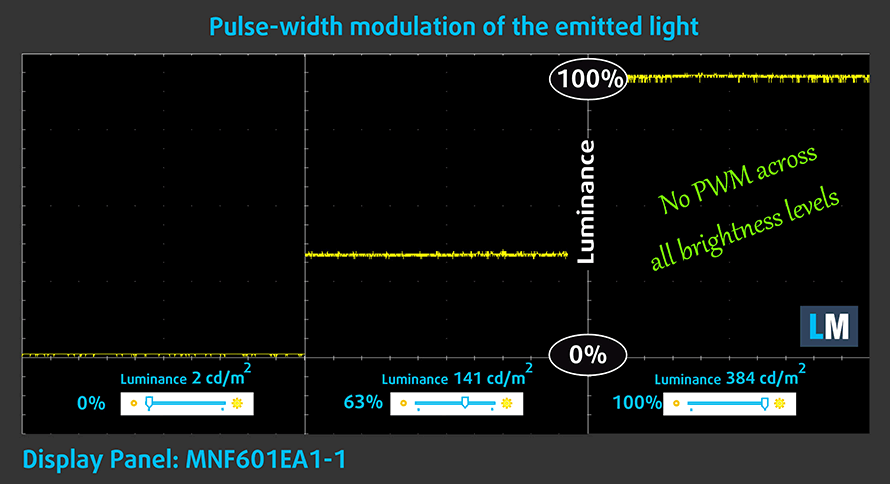
Blue light emissions
Installing our Health-Guard profile not only eliminates PWM but also reduces the harmful Blue Light emissions while keeping the colors of the screen perceptually accurate. If you’re not familiar with the Blue light, the TL;DR version is – emissions that negatively affect your eyes, skin, and your whole body. You can find more information about that in our dedicated article on Blue Light.
Conclusion
Lenovo ThinkBook 15p’s IPS panel has a very high detailed image, thanks to the UHD resolution. It also supports HDR with its 500 nits of maximum brightness, and provides comfortable viewing angles and a good contrast ratio. Ultimately, it has a very high color coverage and displays 91% of the DCI-P3 color gamut. Slightly on the downside, its color accuracy is a bit off, but with an Average dE of 3.2 with our Gaming and Web design profile, the situation is not that bad.
Buy our profiles
Since our profiles are tailored for each individual display model, this article and its respective profile package are meant for Lenovo ThinkBook 15p configurations with 15.6″ UHD IPS MNF601EA1-1 (CSO1500).
*Should you have problems with downloading the purchased file, try using a different browser to open the link you’ll receive via e-mail. If the download target is a .php file instead of an archive, change the file extension to .zip or contact us at [email protected].
Read more about the profiles HERE.
In addition to receiving efficient and health-friendly profiles, by buying LaptopMedia's products you also support the development of our labs, where we test devices in order to produce the most objective reviews possible.

Office Work
Office Work should be used mostly by users who spend most of the time looking at pieces of text, tables or just surfing. This profile aims to deliver better distinctness and clarity by keeping a flat gamma curve (2.20), native color temperature and perceptually accurate colors.

Design and Gaming
This profile is aimed at designers who work with colors professionally, and for games and movies as well. Design and Gaming takes display panels to their limits, making them as accurate as possible in the sRGB IEC61966-2-1 standard for Web and HDTV, at white point D65.

Health-Guard
Health-Guard eliminates the harmful Pulse-Width Modulation (PWM) and reduces the negative Blue Light which affects our eyes and body. Since it’s custom tailored for every panel, it manages to keep the colors perceptually accurate. Health-Guard simulates paper so the pressure on the eyes is greatly reduced.
Get all 3 profiles with 33% discount
Sound
Lenovo ThinkBook 15p’s Harman speakers produce a sound of very good quality. Its low, mid, and high tones are clear of deviations.
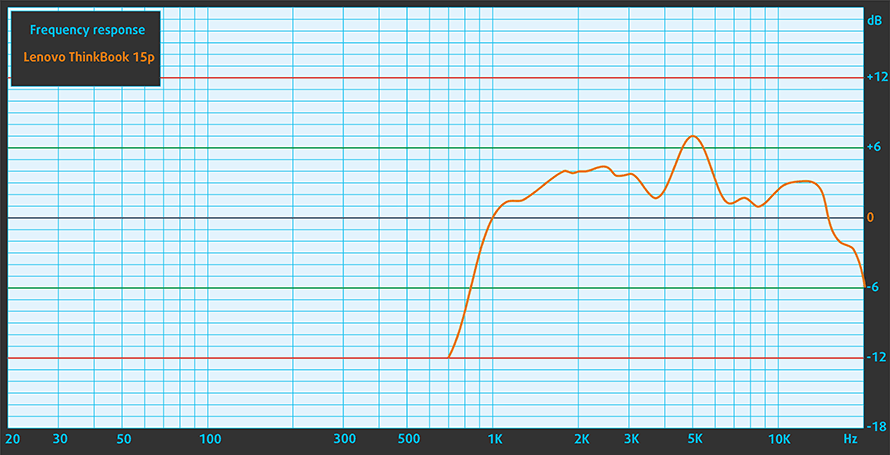
Drivers
All of the drivers and utilities for this notebook can be found here: https://pcsupport.lenovo.com/us/en/products/laptops-and-netbooks/thinkbook-series/thinkbook-15p-imh/downloads/automatic-driver-update
Battery
Now, we conduct the battery tests with Windows Better performance setting turned on, screen brightness adjusted to 120 nits, and all other programs turned off except for the one we are testing the notebook with. Here, we have a 57Wh battery, which lasts for 8 hours and 37 minutes of Web browsing, and 6 hours and 13 minutes of video playback.
In order to simulate real-life conditions, we used our own script for automatic web browsing through over 70 websites.
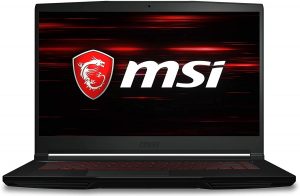
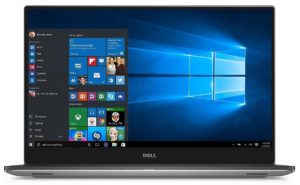
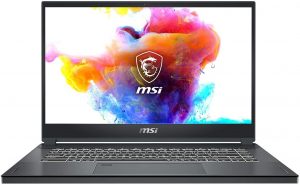
For every test like this, we use the same video in HD.



CPU options
Lenovo is offering this notebook with one of three processors – the Core i5-10300H, Core i7-10750H, and the Core i7-10870H – four, six, and eight-core CPUs respectively.
Results are from the Cinebench 20 CPU test (the higher the score, the better)
Results are from our Photoshop benchmark test (the lower the score, the better)
GPU options
In terms of the graphics card, you can pick from the GTX 1650 Max-Q and the GTX 1650 Ti Max-Q, both equipped with 4GB of GDDR6 memory.
Results are from the 3DMark: Time Spy (Graphics) benchmark (higher the score, the better)
Results are from the 3DMark: Fire Strike (Graphics) benchmark (higher the score, the better)
Results are from the Unigine Superposition benchmark (higher the score, the better)
Gaming tests

| Far Cry 5 | Full HD, Normal (Check settings) | Full HD, High (Check settings) | Full HD, Ultra (Check settings) |
|---|---|---|---|
| Average fps | 69 fps | 64 fps | 60 fps |

| Rise of the Tomb Raider (2016) | Full HD, Lowest (Check settings) | Full HD, Medium (Check settings) | Full HD, Very High (Check settings) |
|---|---|---|---|
| Average fps | 102 fps | 81 fps | 41 fps |

| Shadow of the Tomb Raider (2018) | Full HD, Lowest (Check settings) | Full HD, Medium (Check settings) | Full HD, High (Check settings) |
|---|---|---|---|
| Average fps | 87 fps | 58 fps | 53 fps |

| Tom Clancy’s Ghost Recon Wildlands | Full HD, Medium (Check settings) | Full HD, High (Check settings) | Full HD, Very High (Check settings) |
|---|---|---|---|
| Average fps | 63 fps | 58 fps | 50 fps |
Temperatures and comfort
Max CPU load
In this test we use 100% on the CPU cores, monitoring their frequencies and chip temperature. The first column shows a computer’s reaction to a short load (2-10 seconds), the second column simulates a serious task (between 15 and 30 seconds), and the third column is a good indicator of how good the laptop is for long loads such as video rendering.
Average core frequency (base frequency + X); CPU temp.
| Intel Core i7-10750H (45W TDP) | 0:02 – 0:10 sec | 0:15 – 0:30 sec | 10:00 – 15:00 min |
|---|---|---|---|
| Lenovo ThinkBook 15p | 3.48 GHz (B+34%) @ 89°C | 3.13 GHz (B+20%) @ 85°C | 2.83 GHz (B+9%) @ 75°C |
| MSI GF63 10SCXR | 3.31 GHz (B+27%) @ 83°C | 3.20 GHz (B+23%) @ 86°C | 2.80 GHz (B+8%) @ 87°C |
| Acer Nitro 5 (AN515-55) | 3.02 GHz (B+16%) @ 82°C | 3.04 GHz (B+17%) @ 92°C | 2.67 GHz (B+3%) @ 92°C |
| Lenovo Legion 7 (15) | 3.78 GHz (B+45%) @ 80°C | 3.69 GHz (B+42%) @ 83°C | 3.51 GHz (B+35%) @ 83°C |
| MSI GP65 Leopard 10Sx | 3.65 GHz (B+40%) @ 95°C | 3.41 GHz (B+31%) @ 95°C | 3.30 GHz (B+27%) @ 95°C |
The cooling looks and works very well on this laptop. Lenovo was also a bit lenient on the power delivery, which additionally aids the cooling setup
Real-life gaming
| NVIDIA GeForce GTX 1650 Ti Max-Q | GPU frequency/ Core temp (after 2 min) | GPU frequency/ Core temp (after 30 min) |
|---|---|---|
| Lenovo ThinkBook 15p | 1594 MHz @ 64°C @ 50W | 1581 MHz @ 68°C @ 50W |
Interestingly, despite the Max-Q branding, the ThinkBook 15p manages to run its GTX 1650 Ti Max-Q at 50W, which delivers a performance very similar to the non-Max-Q model. And it does so at a quite low temperature.
Comfort during combined load
And the low temperature on the inside results in a low temperature on the outside, where we measured a maximum of just below 40°C.
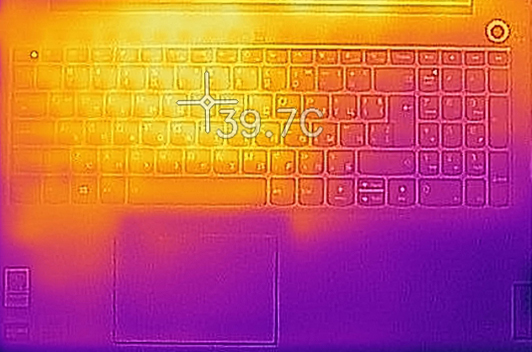
Verdict
There are a couple of things we want to get out of the way. First – the I/O. It is generally good with quite an amount of ports and even a full-sized SD card reader. However, the USB Type-C port has a speed of only 5Gbps, and it can be used only for data transfer – no fancy Thunderbolt, nor DisplayPort capabilities.
Then, the battery life… Although we got a bit over 8 hours and a half of Web browsing, the video playback times were not ideal – just over 6 hours. This is mainly because of the 4K IPS panel we had in use, but to be honest, Lenovo could have equipped this laptop with a larger battery. There is a good amount of unused (or poorly used) space inside, so for the next generation, we really hope to see something bigger.
Other than that, the build quality feels good. Even though the lid bends like crazy, the base remains solid, and the aluminum all around makes the laptop feel very premium (as its price tag suggests). We were not really impressed by the keyboard, but it is good to have a backlight, and the fingerprint reader in the Power button seems fast and accurate.
As for the performance – it is there. These H-series processors will deliver on what you expect from them, but content creators and people with more intensive work should go for one of the Core i7 options. Not only that, but you can play some AAA titles thanks to the GTX 1650/1650 Ti Max-Q at reasonably high settings. Well, this is if you play at 1080p because, at 4K, you’ll need something a lot beefier than that.
Lenovo ThinkBook 15p’s IPS panel (MNF601EA1-1 (CSO1500)) has a very high detailed image, thanks to the UHD resolution. It also supports HDR with its 500 nits of maximum brightness and provides comfortable viewing angles and a good contrast ratio. Ultimately, it has a very high color coverage and displays 91% of the DCI-P3 color gamut. Slightly on the downside, its color accuracy is a bit off, but with an Average dE of 3.2 with our Gaming and Web design profile, the situation is not that bad.
Not in the last place, there is the comfort of use. Ultimately, the fans don’t kick in, unless you put some load on the device, so for the most time, you will enjoy a quiet experience. And the speakers? Well, Harman has done a good job, tuning them, as they sound loud and rich for the most part. Well, they are not Dell XPS or MacBook quality, but still – they’re decent.
Keep in mind that the ThinkBook 15p sits in an area of the market, that’s between the business and the content creator segments. So, if you’re in for both of them, it’s not a bad choice. However, if you need more performance, MSI’s Creator 15 A10Sx packs a lot of power, but you need to have deeper pockets.
Pros
- Takes up to 32GB of DDR4 memory and has two M.2 slots
- 4K IPS panel option with 91% of DCI-P3 coverage (MNF601EA1-1 (CSO1500))
- Doesn’t use PWM for brightness adjustment (MNF601EA1-1 (CSO1500))
- HDR 500 support (MNF601EA1-1 (CSO1500))
- Capable hardware within a sleek, portable chassis
- Fingerprint reader + Wi-Fi 6 support
- Features an SD card reader
- Packs good security features
Cons
- Doesn’t have a Thunderbolt connection, and the USB Type-C port can only be used for data transfer
- Bendy lid
You can check the prices and configurations in our Specs System: https://laptopmedia.com/series/lenovo-thinkbook-15p/
